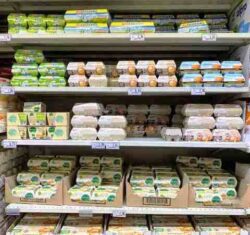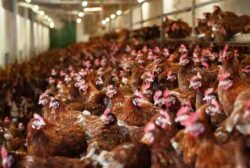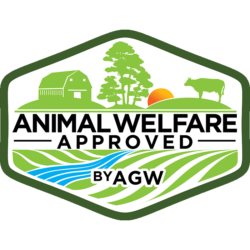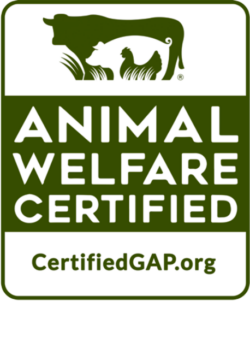Read Time: 7 Minutes Subscribe & Share
Where Are The Eggs?
 A funny thing happened to me in the grocery store, when I first arrived in Bologna. I decided to write my grocery list in Italian and try to understand why one egg is masculine and two or more have the singular feminine ending. I shopped for eggs, and of course went to several refrigerated displays — dairy, meat, fish, cheese, pastas, wine to go. No eggs to be found — masculine or feminine. That is because they are stocked on room-temperature shelves, along with dried pasta and coffee and across from lightbulbs and Band Aids. Eggs are not inexpensive here and are normally sold in boxes of six — not a dozen. So why, you might ask, are they stored at a freshness-challenging temperature? One good clue is that the EU regulations are a bit different than ours.
A funny thing happened to me in the grocery store, when I first arrived in Bologna. I decided to write my grocery list in Italian and try to understand why one egg is masculine and two or more have the singular feminine ending. I shopped for eggs, and of course went to several refrigerated displays — dairy, meat, fish, cheese, pastas, wine to go. No eggs to be found — masculine or feminine. That is because they are stocked on room-temperature shelves, along with dried pasta and coffee and across from lightbulbs and Band Aids. Eggs are not inexpensive here and are normally sold in boxes of six — not a dozen. So why, you might ask, are they stored at a freshness-challenging temperature? One good clue is that the EU regulations are a bit different than ours.
Vaccine Vs Bath
Curiosity about the price differences and why refrigeration or not led to a quick check via our helpful internet browser. Reading through several sources reveals that chickens in the EU are vaccinated against salmonella, which they are not in the US. Eggs in my home country are washed in warm water with a detergent, then they are rinsed and cleaned with sanitizer and dried. While the American eggshells might be squeakier clean, the process does remove the cuticle, a natural film that protects the interior of the egg from invasive bacteria. Government regulations in Japan, Australia and some Scandinavian countries require the same process. Both methods – chicken vaccination and shell sanitizing – are equally effective at protecting the product.
But by not removing the protective cuticle, the egg is naturally free of the danger of invading pathogens, and so eggs are safe at room temperature. Irradiation is also used in the US to neutralize pathogens such as salmonella. At one time, it is rumored grocery store chains could send back eggs that had exceeded their sell-by date, have them irradiated and a new sell-by date attached. I haven’t been able to verify that one. I still put my eggs here in the fridge and use them within a week or so. In Italy, each egg is stamped with a producer code, as required by the EU. This is used to trace any pathogen outbreak. While the EU has some official-looking labels for types of eggs, the US has more, so I thought I would share with KD readers some light research.
Behind the Label
Being label-conscious is not just about the clothes we wear and the purses and shoes we sport. I know that US certification labels for meat have been degraded over the decades, so I believe it’s important to know what you are buying into when you grab a dozen eggs. The overwhelming majority of eggs produced globally are conventional, and regulations vary from nation to nation. But I had no real understanding of what the labels meant in the US or in the EU. The EU system, it turns out, is imperfect but riddled with less obfuscation than the US version.
Conventional
Conventional eggs really are usually sold with little information as to provenance or stewardship – they are the least expensive egg you will find in your grocery store. These inexpensive eggs have been produced by hens kept in battery cages. They normally house nine birds per cage, giving each hen less room than a sheet of printer paper. They can’t flap their wings, root around in the ground, or even dust off their feathers – all behaviors they like to engage in. The cages are positioned over troughs for receiving eggs and also for removing manure. The average life of these chickens is a bit over a year.
stewardship – they are the least expensive egg you will find in your grocery store. These inexpensive eggs have been produced by hens kept in battery cages. They normally house nine birds per cage, giving each hen less room than a sheet of printer paper. They can’t flap their wings, root around in the ground, or even dust off their feathers – all behaviors they like to engage in. The cages are positioned over troughs for receiving eggs and also for removing manure. The average life of these chickens is a bit over a year.
In comparison, the average life span of a barnyard chicken is about six to eight years, but their egg laying capacity decreases with age. In battery cage and cage-free layers, once they have neared the end of their best egg laying capacity, they are killed by grinding or gassing. You can imagine the disease and fatality level that has to be addressed in this type of environment. Male chicks are destroyed in a similar manner shortly after birth, which is why in the US you don’t see capons (castrated roosters) or roosters for a real coq au vin – a real shame as a rooster cooked in red wine is nothing like the flaccid version produced with a female chicken.
 The EU banned battery cages in 2009, although it took several years to be fully implemented. The poultry industry, which seems never at a loss for inventiveness, came up with “enriched cages” for layers where there is some more room, litter for them to scratch through, and outfitted with perches -chickens do love a nice perch – some have access to a nesting box but still in a cage with no recess. Some are even outfitted with little lawn green scratch pads. These enriched cages are in poorly ventilated and dimly lit sheds with no access to an outside poultry playground, just like their unenriched versions.
The EU banned battery cages in 2009, although it took several years to be fully implemented. The poultry industry, which seems never at a loss for inventiveness, came up with “enriched cages” for layers where there is some more room, litter for them to scratch through, and outfitted with perches -chickens do love a nice perch – some have access to a nesting box but still in a cage with no recess. Some are even outfitted with little lawn green scratch pads. These enriched cages are in poorly ventilated and dimly lit sheds with no access to an outside poultry playground, just like their unenriched versions.
Cage Free
Definitely a rung up from enriched cages, but it does not address a couple of important issues. Chickens are kept in a shed for their entire lives but on a floor with litter they can peck and scratch through. They can take dust baths (something they love to do) and stretch their wings. They have unlimited access to food and water. Quarters are pretty crowded, though, and there is no outdoor access and the feed (like that given to caged chickens) is most likely treated with chemicals – glyphosate being one of them. Like both types of caged layers, their beaks are burned off to keep them from pecking themselves and others in frustration.
are kept in a shed for their entire lives but on a floor with litter they can peck and scratch through. They can take dust baths (something they love to do) and stretch their wings. They have unlimited access to food and water. Quarters are pretty crowded, though, and there is no outdoor access and the feed (like that given to caged chickens) is most likely treated with chemicals – glyphosate being one of them. Like both types of caged layers, their beaks are burned off to keep them from pecking themselves and others in frustration.
Free Range
Still an improvement over the above real estate allotted to our layers. These hens are allowed outdoor access, and that access has to be a minimum of two square feet per bird. They are housed in a shed at night. There is no requirement to provide anything other than industrial chicken feed. Again the allotted minimal space requirements in the shed for “free range” allows large farms to pay only lip service to the certification. Other poultry farmers who want to have healthier chickens but do not want to pay for the organic certification costs will exceed these minimum requirements. It pays to do a little research on who your free range egg farmer is.
Organic
This certification by the USDA requires that the hens be at least cage-free, fed an organic diet (free of pesticides and not treated with hormones and antibiotics) plus have at least a nominal access to the outdoors. This access is usually a small door to a minimal amount of space and since hens are very communal, most of them don’t take advantage of it during their very short lives. So, again, it depends on the egg producer how the guidelines are bent for profit or exceeded to insure the intent of that term.
Organic Pasture Raised
 In the US, this phrase is almost the gold standard. But it also should have a third party certification of
In the US, this phrase is almost the gold standard. But it also should have a third party certification of Certified Humane or “Animal Welfare Approved” from organizations such as A Greener World (AGW), Certified Humane and Global Animal Partnership (GAP). Any of these additional stamps give the consumer the assurance that the egg producer has embraced the intent of the ruling and not evaded its principles.
Certified Humane or “Animal Welfare Approved” from organizations such as A Greener World (AGW), Certified Humane and Global Animal Partnership (GAP). Any of these additional stamps give the consumer the assurance that the egg producer has embraced the intent of the ruling and not evaded its principles.
 Since I was seduced by some of these terms when buying not only eggs, but also produce and meat, I thought it useful to include these labels. The following terms on eggs are meaningless, according to the Animal Welfare Institute. I include their preface below.
Since I was seduced by some of these terms when buying not only eggs, but also produce and meat, I thought it useful to include these labels. The following terms on eggs are meaningless, according to the Animal Welfare Institute. I include their preface below.
Many food labels that address the raising of farm animals are confusing, if not downright misleading. While some animal-raising claims have standards established by law or government policy, most are undefined. In addition, most label claims are “self made” by the company merely for marketing purposes, and in these cases, the accuracy of the claim is not verified. The exceptions are “certified” food products, where compliance with a formal set of standards has been verified by an independent third-party audit.
Vegetarian Fed
USDA Process Verified
Ethically Responsible
Thoughtfully Raised
Halal
Humanely Raised or Humanely Handled
Kosher
Natural or Naturally Raised
No Added Hormones
Omega 3 Enriched
UEP Certified
But if you buy your eggs armed with knowledge of what was intended in terms of the stewardship and health of our plucky little layers, you would have the benefit of the following nutritional bonus. According to a 2007 Mother Earth News survey of 14 flocks of truly pasture-raised eggs compared to a USDA nutrition statistical survey of conventional eggs, the pasture-raised eggs contained ⅓ less cholesterol, ⅔ more Vitamin A, two times more Omega-3 fatty acids, three times more Vitamin E and seven times more beta carotene. Our birds more than amply repay us for treating them kindly.

Kitchen Detail shares under the radar recipes, explores the art of cooking, the stories behind food, and the tools that bring it all together, while uncovering the social, political, and environmental truths that shape our culinary world.




So much to sift through to see the truth. I wonder if ANY grocery store eggs meet this standard?
Maybe some of your readers will know, I do not.
Hello Tarah,
Exactly! The problem is that the standards set by the US government have been so weakened by big Ag that third party verification has had to step into the breach. You have a better chance at a Farm market.
Greatly debated topic, Nancy. I was consuming/baking with organic, cage free eggs for years, until I recently learned that the best eggs nutritionally are “pastured” eggs. I immediately noticed that the pastured chicken egg yolks are far more orange than the organic, cage free versions. I learned years ago the reason US eggs are refrigerated, yet I never felt comfortable buying eggs from a local farmer who never refrigerated their eggs OR dated the carton. Therefore, pastured eggs from Trader Joe’s are my go to eggs, as I consume two every single day. Let’s hope that the darned bird flu… Read more »
Hello Diane,
Yes Victoria Sackett, the KD editor swears by TraderJoe eggs. I never thought to look there.
Thank you. This is so helpful.
Hello Leslie,
It is so confusing and even at MOMs (who try to offer only organic choices.
Many thanks for your research into egg production in the various industrial methods. As consumers in the grocery store we are confronted with all sorts of labeling that reveal so little about the product. Your little treatise is helpful.
I used to be skeptical about shelf-labeling marketing claims intended to convince us that some eggs are superior to others. Some trial purchases convince me that more naturally raised eggs indeed are noticeably better as prepared cooked eggs. (Differences are not obvious in batters.)
Hello David,
So nice to hear from you! Yes, you are right about eggs in batter, perhaps the color in the yolks affects a vanilla cake batter. But the taste difference in cooked eggs can be remarkable.
Nancy